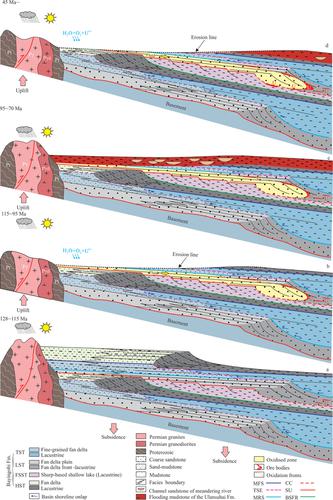当前位置:
X-MOL 学术
›
Acta Geol. Sinica Engl. Ed.
›
论文详情
Our official English website, www.x-mol.net, welcomes your
feedback! (Note: you will need to create a separate account there.)
Sequence Stratigraphy of the Lower Cretaceous Uraniferous Measures and Mineralization of the Sandstone-hosted Tamusu Large Uranium Deposit, North China
Acta Geologica Sinica-English Edition ( IF 3.5 ) Pub Date : 2021-07-05 , DOI: 10.1111/1755-6724.14792 Bo LIU 1, 2 , Zhiqiang SHI 1 , Yunbiao PENG 2 , Pengfei ZHANG 1 , Peng LI 2
Acta Geologica Sinica-English Edition ( IF 3.5 ) Pub Date : 2021-07-05 , DOI: 10.1111/1755-6724.14792 Bo LIU 1, 2 , Zhiqiang SHI 1 , Yunbiao PENG 2 , Pengfei ZHANG 1 , Peng LI 2
Affiliation

|
The Bayingobi basin is the Mesozoic–Cenozoic basin in North China in which the Tamusu uranium deposit is located. The ore-target layer of the deposit is the Lower Cretaceous Bayingobi Formation, which developed as a fan delta-shallow lacustrine deposit. The distributary channel sand body of the fan delta plain and the underwater distributary channel sand body of the fan delta front formed a favorable uranium reservoir, so the study of sequence stratigraphy is extremely important to understanding the genesis of uranium deposits. On the basis of field investigation and a large number of borehole logs, the high resolution sequence stratigraphy of the Lower Cretaceous is divided and the system tracts of different periods are established. The relationship between deposition, interlayer oxidation and uranium enrichment is discussed. The Lower Cretaceous Bayingobi Formation can be divided into two fourth-order sequences (Sq1 and Sq2). The lower member of the Bayingobi Formation is referred to as Sq1, which is composed of a falling-stage system tract (FSST) on top. On the other hand, the upper member of the Bayingobi Formation is referred to as Sq2, which is composed of a lowstand system tract (LST), transgressive system tract (TST) and highstand system tract (HST). The lowstand system tract forms a favorable stratigraphic structure (mud-sand-mud formation) with the lacustrine mudstone of the overlying transgressive system tract, that is conducive for the migration of uranium-bearing oxygen water. The organic matter and pyrite in the fan delta sand body, as well as the dark mudstone in the distributary bay, provided a reducing medium for uranium mineralization. The ore body mainly occurs in the distributary channel, underwater distributary channel or the mouth bar of the fan delta. As a result of the moderate thickness, high permeability, favorable barrier and rich reducing medium, the rich ore body mainly occurs in the underwater distributary channel and mouth bar sand body of the delta front. Based on study of the sequence stratigraphy, the model of the sequence, sedimentation and mineralization of the uranium deposit is established, which enriches uranium metallogenic theory and provides a reference for exploration of the same type of uranium deposits.
中文翻译:

华北砂岩型塔木苏大型铀矿床下白垩统铀系层序地层及成矿作用
巴音戈壁盆地是华北中、新生代盆地,塔木苏铀矿就位于其中。矿床目标层为下白垩统巴音戈壁组,发育为扇三角洲—浅湖相矿床。扇三角洲平原的分流河道砂体和扇三角洲前缘的水下分流河道砂体形成了有利的铀储层,因此层序地层学研究对于认识铀矿床的成因极为重要。在野外调查和大量钻孔测井资料的基础上,划分了下白垩统高分辨率层序地层,建立了不同时期的体系域。讨论了沉积、层间氧化和铀浓缩之间的关系。下白垩统巴音戈壁组可划分为两个四级层序(Sq1和Sq2)。Bayingobi组的下段称为Sq1,其顶部由下降阶段系统域(FSST)组成。另一方面,巴音戈壁组上段称为Sq2,由低位体系域(LST)、海进体系域(TST)和高位体系域(HST)组成。低位体系域与上覆海侵体系域的湖相泥岩形成有利的地层结构(泥砂泥地层),有利于含铀氧水的运移。扇三角洲砂体中的有机质和黄铁矿,以及分流湾的深色泥岩,为铀矿化提供了还原介质。矿体主要产于扇三角洲的分流河道、水下分流河道或河口坝。由于厚度适中、渗透率高、阻隔性好、还原介质丰富,富矿体主要产于三角洲前缘水下分流河道和河口坝砂体。在层序地层研究的基础上,建立了铀矿层序、沉积和成矿模型,丰富了铀成矿理论,为同类型铀矿的勘探提供了参考。富矿体主要产于三角洲前缘水下分流河道和河口坝砂体。在层序地层研究的基础上,建立了铀矿层序、沉积和成矿模型,丰富了铀成矿理论,为同类型铀矿的勘探提供了参考。富矿体主要产于三角洲前缘水下分流河道和河口坝砂体。在层序地层研究的基础上,建立了铀矿层序、沉积和成矿模型,丰富了铀成矿理论,为同类型铀矿的勘探提供了参考。
更新日期:2021-07-05
中文翻译:

华北砂岩型塔木苏大型铀矿床下白垩统铀系层序地层及成矿作用
巴音戈壁盆地是华北中、新生代盆地,塔木苏铀矿就位于其中。矿床目标层为下白垩统巴音戈壁组,发育为扇三角洲—浅湖相矿床。扇三角洲平原的分流河道砂体和扇三角洲前缘的水下分流河道砂体形成了有利的铀储层,因此层序地层学研究对于认识铀矿床的成因极为重要。在野外调查和大量钻孔测井资料的基础上,划分了下白垩统高分辨率层序地层,建立了不同时期的体系域。讨论了沉积、层间氧化和铀浓缩之间的关系。下白垩统巴音戈壁组可划分为两个四级层序(Sq1和Sq2)。Bayingobi组的下段称为Sq1,其顶部由下降阶段系统域(FSST)组成。另一方面,巴音戈壁组上段称为Sq2,由低位体系域(LST)、海进体系域(TST)和高位体系域(HST)组成。低位体系域与上覆海侵体系域的湖相泥岩形成有利的地层结构(泥砂泥地层),有利于含铀氧水的运移。扇三角洲砂体中的有机质和黄铁矿,以及分流湾的深色泥岩,为铀矿化提供了还原介质。矿体主要产于扇三角洲的分流河道、水下分流河道或河口坝。由于厚度适中、渗透率高、阻隔性好、还原介质丰富,富矿体主要产于三角洲前缘水下分流河道和河口坝砂体。在层序地层研究的基础上,建立了铀矿层序、沉积和成矿模型,丰富了铀成矿理论,为同类型铀矿的勘探提供了参考。富矿体主要产于三角洲前缘水下分流河道和河口坝砂体。在层序地层研究的基础上,建立了铀矿层序、沉积和成矿模型,丰富了铀成矿理论,为同类型铀矿的勘探提供了参考。富矿体主要产于三角洲前缘水下分流河道和河口坝砂体。在层序地层研究的基础上,建立了铀矿层序、沉积和成矿模型,丰富了铀成矿理论,为同类型铀矿的勘探提供了参考。











































 京公网安备 11010802027423号
京公网安备 11010802027423号